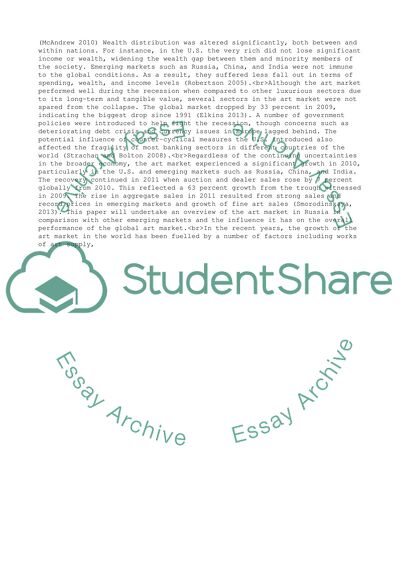
- Home
- Free Samples
- Premium Essays
- Editing Services
- Extra Tools
- Essay Writing Help
- About Us
- Studentshare
- Subjects
- Visual Arts & Film Studies
- Overview of the Russian Art Market
Overview of the Russian Art Market - Case Study Example

- Subject: Visual Arts & Film Studies
- Type: Case Study
- Level: High School
- Pages: 25 (6250 words)
- Downloads: 0
- Author: dean96
Extract of sample "Overview of the Russian Art Market"
The paper “Overview of the Russian Art Market” is an entertaining example of visual arts case study. In recent years, the art market has been one of the most active across the globe. E.g., the global recession that began in 2007 is regarded as one of the most severe recessions since the 1930s as it led to the collapse of property and stock markets in different countries all over the world. It also contributed to the collapse of various major financial institutions in the world. The uncertainty and recession that followed significantly influenced the wealth, income, and confidence of consumers, causing a decline in market performance across Europe and the U.S. (McAndrew 2010) Wealth distribution was altered significantly, both between and within nations.
For instance, in the U.S. the very rich did not lose significant income or wealth, widening the wealth gap between them and minority members of the society. Emerging markets such as Russia, China, and India were not immune to the global conditions. As a result, they suffered less fall out in terms of spending, wealth, and income levels (Robertson 2005). Although the art market performed well during the recession when compared to other luxurious sectors due to its long-term and tangible value, several sectors in the art market were not spared from the collapse.
The global market dropped by 33 percent in 2009, indicating the biggest drop since 1991 (Elkins 2013). A number of government policies were introduced to help fight the recession, though concerns such as deteriorating debt crisis and currency issues in Europe lagged behind. The potential influence of counter-cyclical measures the U.S. introduced also affected the fragility of most banking sectors in different countries of the world (Strachan and Bolton 2008). Regardless of the continuing uncertainties in the broader economy, the art market experienced significant growth in 2010, particularly in the U.S. and emerging markets such as Russia, China, and India.
The recovery continued in 2011 when auction and dealer sales rose by 7 percent globally from 2010. This reflected a 63 percent growth from the trough witnessed in 2009.
...Download file to see next pages Read More
- TERMS & CONDITIONS
- PRIVACY POLICY
- COOKIES POLICY